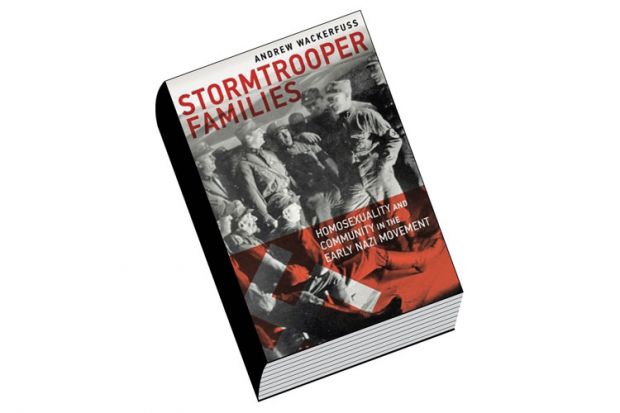It is a rare achievement indeed to tell us something new about Nazism. Through its in-depth exploration of “everyday” life within Hamburg’s Sturmabteiling (SA), the Nazi Party’s paramilitary group, Andrew Wackerfuss’ rich and readable book does just that.
His narrative begins with an exploration of the childhoods of future stormtroopers during Hamburg’s imperial heyday, before considering the way these men responded to the troubles of the First World War, its humiliating end, and the difficult founding of the Weimar Republic. This is more than mere background material, instead offering a new and enlightening exploration of the changes and challenges that drove Germany through industrialisation, to war, away from monarchy, and into an ultimately doomed republican experiment. Wackerfuss’ skill as a writer is immediately clear as he provides compelling insight into the lives of those ordinary citizens who would become swayed by right-wing nationalism’s promise of reclaiming a past greatness they remembered or imagined from their childhoods.
From its beginnings in 1922, Hamburg’s Sturmabteiling, like, one imagines, most of Germany’s other stormtrooper units, was the product of both nationalist and national ideological views and deeply local cultural conditions. Its motley crews of extreme right-wingers and relatively down-and-out young men developed deep bonds, and these interpersonal connections would serve to cement members to the Nazi cause and to each other. Through its social insurance schemes, group homes and soup kitchens, the SA operated not just as a band of ideologically driven thugs, but also as an alternative, extra-political social welfare agency. The SA’s street fights serve as an important counterpoint to these good deeds, but Wackerfuss, while far from an apologist, is careful to appoint blame equally, including to the police, and to contextualise the group’s political violence within the wider context of Weimar paramilitary associations, and he considers how and why the group’s political battles resonated outside Nazi circles.
Sometimes stormtrooper solidarity crossed the line from homosocial to homosexual. However, despite being painted as a hotbed of homosexual perversion by its left-wing opponents, the Nazi Party from 1934 and various post-war historians, if the Sturmabteiling was the site of immoral activity, it was for its violent extremism and not for its sexual proclivities. Although it was a male-centric group, stormtroopers took pains to include their female supporters, the “culture bearers” of Nazism, and Wackerfuss’ nuanced exploration of gender dynamics is refreshing in a male-dominated field. More importantly, his book underscores the tension between the homosociality of the SA and the Nazi Party’s ideological expectations of heterosexuality and family life, a tension that was ultimately to be part of the stormtroopers’ undoing.
My only concern, upon finishing this fascinating book, was whether Wackerfuss’ narrative was an analysis of the “truth behind the connection between sexuality and Nazism”, specifically homosexuality within the Sturmabteiling, or actually a compelling history of the SA itself. Homosexuality, its practice and its treatment are a crucial part of the group’s history, particularly given the execution of Ernst Röhm in the Night of the Long Knives in 1934, but this book’s scope squares somewhat uneasily with its title, which suggests that the narrative will focus on homosexuality within the Sturmabteiling above all else, which it certainly does not.
Although the focus on Hamburg is fascinating and well chosen, a more thorough explanation as to why the author chose this city-state and hotbed of Left‑Right fighting would have been valuable. Instead, we are given a jarring and cumbersome introductory section, which rather lets down the rest of this very readable book, and which almost appears to have been added late in the process — perhaps in order to have the book fit its remit of relaunching Harrington Park Press as a LGBTQ imprint. But if that is so, further explanation would greatly benefit the reader, and would explain why such an in-depth study into a Nazi organisation is prefaced by a section that assumes no knowledge of the Third Reich but a full knowledge of the role that the Sturmabteiling and fascism have played in conceptions of gays and lesbians in the post-war period, the guiding stereotype Wackerfuss wishes to overturn. I was unaware of this connection, and I would have liked to have learned more. But despite these conceptual shortcomings, this book’s narrative is a huge success – although perhaps a different success from that intended.
Victoria Harris is associate research fellow in history, Birkbeck, University of London.
Stormtrooper Families: Homosexuality and Community in the Early Nazi Movement
By Andrew Wackerfuss
Harrington Park Press, 352pp, £62.00 and £24.00
ISBN 9781939594044 and 4051
Published 18 August 2015
Register to continue
Why register?
- Registration is free and only takes a moment
- Once registered, you can read 3 articles a month
- Sign up for our newsletter
Subscribe
Or subscribe for unlimited access to:
- Unlimited access to news, views, insights & reviews
- Digital editions
- Digital access to THE’s university and college rankings analysis
Already registered or a current subscriber?




